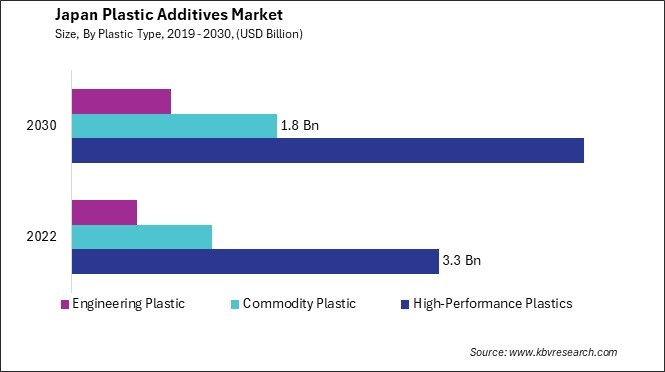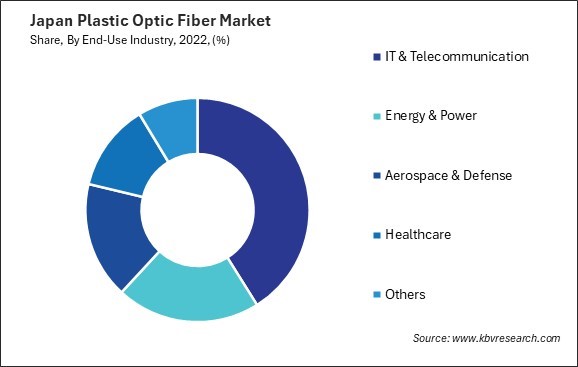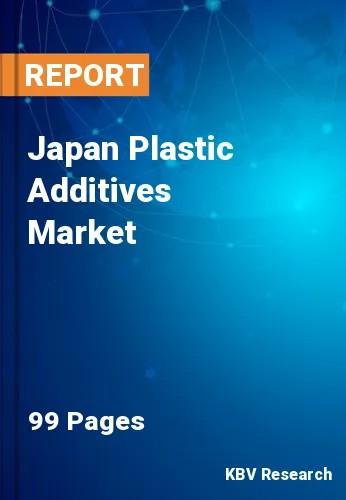The Japan Plastic Additives Market size is expected to reach $7.2 Billion by 2030, rising at a market growth of 4.6% CAGR during the forecast period. In the year 2022, the market attained a volume of 1906.7 Kilo Tonnes, experiencing a growth of 4.4% (2019-2022).
Japan is renowned for its advanced chemical industry and expertise in materials science, which has contributed to the country's leadership in developing and applying innovative plastic additives. The Japan plastic additives market is driven by a strong focus on research and development, technological innovation, and a commitment to producing high-quality, high-performance additives that meet the stringent requirements of diverse industrial applications.

An important technological development in the Japan plastic additives market is the creation of additives that are sustainable and do not harm the environment. As environmental protection and sustainability have become more prominent topics of discussion, the need for additives that enhance the biodegradability, recyclability, and overall environmental impact of plastics has increased. Japan has been at the forefront of developing bio-based additives, recycled content additives, and additives that facilitate the recycling and reusability of plastics, aligning with global efforts towards a circular economy.
Moreover, Japan has made significant strides in developing specialty additives that impart specific properties to plastics, catering to the evolving needs of industries such as automotive, electronics, packaging, and healthcare. These specialty additives include flame retardants, impact modifiers, UV stabilizers, and antimicrobial agents, which are designed to enhance plastics' performance, durability, and functionality in diverse applications.
Furthermore, Japan's focus on innovation has led to the development of additives that improve the processing characteristics of plastics, such as flow modifiers, lubricants, and processing aids. These additives help optimize the manufacturing process, improve productivity, and reduce energy consumption, contributing to the overall efficiency and competitiveness of the Japanese plastics industry.
The pandemic prompted industry players to adapt their strategies and innovate in response to changing market dynamics. This includes the development of additives tailored to emerging market needs, such as antimicrobial additives for hygiene-sensitive applications or additives that improve the recyclability of plastics to address sustainability concerns. Further developments and innovations in the materials science and chemical engineering sector, which Japan maintains at its forefront, are anticipated to impact the plastic additives industry both domestically and internationally in the coming years.
UV stabilizers are additives that prevent the deterioration of plastics, which can result from sunlight exposure via embrittlement, discoloration, and loss of mechanical properties. One of the key drivers of the growing demand for UV stabilizers in Japan is the increasing use of plastics in outdoor and high-exposure applications. As industries seek to replace traditional materials with plastics due to their lightweight, durability, and cost-effectiveness, the need to protect these plastics from UV degradation becomes essential. UV stabilizers help maintain plastics' aesthetic and functional properties, extending their service life and reducing maintenance costs.
Moreover, Japan's stringent environmental regulations and standards have also contributed to the demand for UV stabilizers. With a focus on sustainability and product quality, industries are seeking additives that comply with regulatory requirements and ensure the long-term performance of their products. UV stabilizers that offer high efficiency, durability, and compatibility with different resin systems are particularly sought after in the Japan market.
Furthermore, Japan's automotive industry, known for its high-quality standards and technological innovation, has been a significant driver of the demand for UV stabilizers. As automotive manufacturers use more plastics in exterior and interior components, there is a growing need for additives to protect them from UV-induced degradation, ensuring that they meet the industry's stringent performance and safety standards. Thus, as industries continue to innovate and seek high-performance materials, the demand for UV stabilizers is expected to remain strong, driving further growth and development in the plastics additives market in Japan.
Japan has witnessed a rapid expansion in the building and construction sector, driven by several factors that have contributed to a surge in construction activities across the country. The Japanese government has launched ambitious initiatives to modernize and upgrade the country's infrastructure, including transportation networks, energy systems, and public facilities. These initiatives have led to a surge in construction projects, such as the development of new airports, railway lines, bridges, and tunnels and the renovation of existing infrastructure to meet modern standards.
Furthermore, urbanization and population growth in Japan have significantly increased the need for residential, commercial, and industrial structures. As more people move to urban areas in search of better opportunities, there is a need for new housing developments, office spaces, retail centers, and industrial facilities to accommodate the growing population and support economic growth. This has increased construction activity in urban and suburban areas, creating opportunities for construction firms, developers, and building material suppliers.
The demand for plastic additives in Japan's construction sector has also been driven by the growing use of plastics in infrastructure projects. Plastics are being used to construct bridges, tunnels, pipelines, and other infrastructure components due to their corrosion resistance, lightweightness, and ease of installation. It is crucial to incorporate additives that improve the structural integrity, durability, and resilience of these plastic materials to environmental factors in order to guarantee the safety and long-term dependability of infrastructure projects.
Furthermore, adopting advanced building technologies and construction methods in Japan has created opportunities for innovative plastic additives that can meet the sector's evolving needs. Additives that offer unique properties, such as self-healing, self-cleaning, or antimicrobial properties, are being developed to address specific challenges in construction, such as maintenance, hygiene, and durability. Hence, all these factors will increase the demand for plastic additives.

In the Japan plastic additives market, several companies play key roles in developing, manufacturing, and distributing a wide range of plastic additives catering to diverse industries and applications. These companies are known for their expertise in materials science, chemical engineering, and innovation, contributing to Japan's plastics additives market leadership.
One prominent player in the Japan plastic additives market is Mitsui Chemicals, Inc., a leading chemical company known for its extensive portfolio of plastic additives and specialty chemicals. Mitsui Chemicals offers a range of additives, including UV stabilizers, flame retardants, impact modifiers, and processing aids, catering to various industries such as automotive, electronics, packaging, and construction. The company's focus on research and development has led to the development of advanced additives that meet the market's evolving needs.
Another significant player is Sumitomo Chemical Co., Ltd., known for its innovative solutions in plastics and chemicals. Sumitomo Chemical offers a diverse range of plastic additives, including heat stabilizers, antioxidants, and lubricants, aimed at improving plastics' performance and processing characteristics. The company's strong presence in Japan's chemical industry and its commitment to sustainability have positioned it as a key player in the plastics additives market.
DIC Corporation is also a notable player in the Japan plastic additives market, offering a wide range of additives and specialty chemicals for plastics. The company's additives portfolio includes UV absorbers, antioxidants, and colorants, among others, designed to enhance the durability, aesthetics, and functionality of plastics used in various applications. DIC Corporation's focus on innovation and customer-centric solutions has contributed to its strong presence in the market.
Other significant players in the Japan plastic additives market include Mitsubishi Chemical Corporation, Asahi Kasei Corporation, and Sanyo Chemical Industries, Ltd.. These companies are known for their expertise in developing and manufacturing high-quality plastic additives that meet the stringent requirements of Japan's industries, contributing to the country's position as a global plastics additives market leader.
By Plastic Type (Volume, Kilo Tonnes, USD Billion, 2019-2023)
By Application (Volume, Kilo Tonnes, USD Billion, 2019-2023)
By Type (Volume, Kilo Tonnes, USD Billion, 2019-2023)
Our team of dedicated experts can provide you with attractive expansion opportunities for your business.

